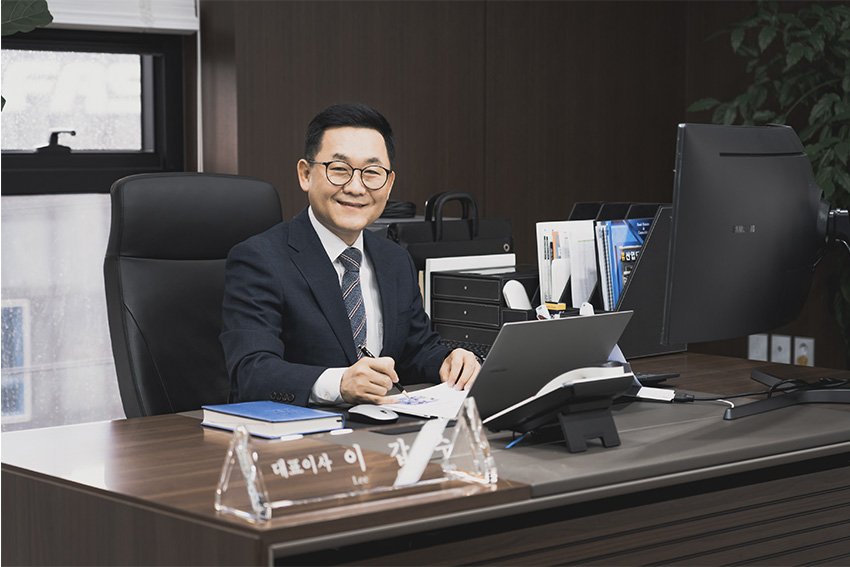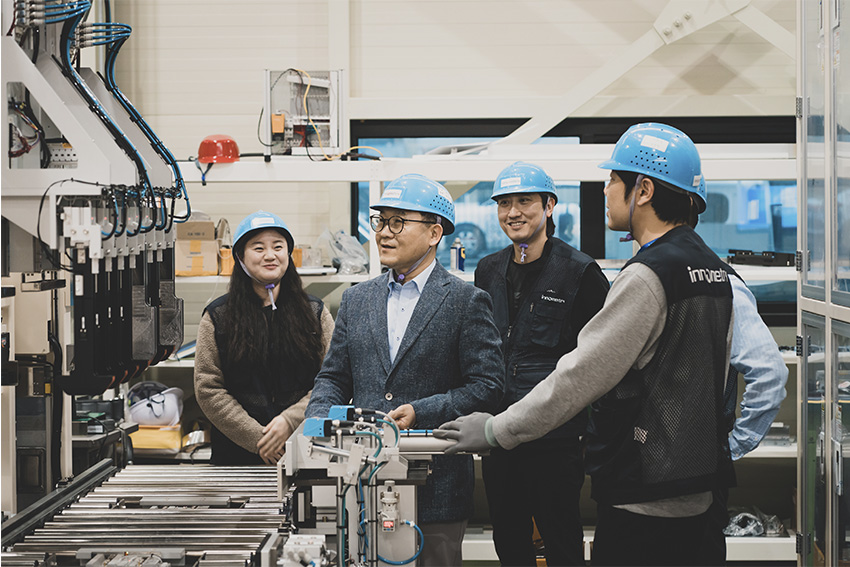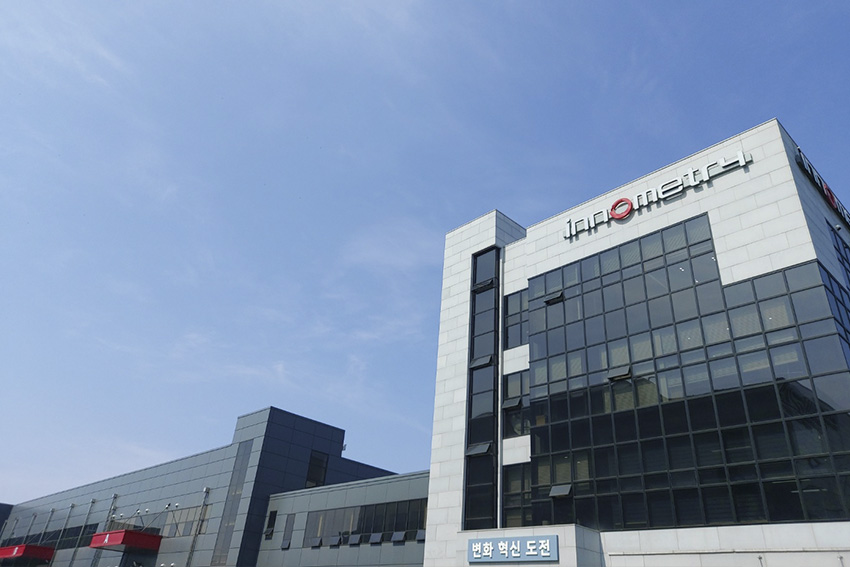While streamlining secondary battery inspection processes is one of the keystones for reducing EV prices, Innometry, a specialist in battery inspection technologies, leverages its new technological developments to seize opportunities with manufacturers worldwide.

Korean SMEs have experienced rapid growth, often benefiting from symbiotic relationships with large Korean MNCs, which provide them with a track record and expertise to excel in the industry. However, to sustain this growth trajectory, they must adopt a more international approach. As an SME that has successfully undergone the internationalization process, how crucial do you believe it is for Korean SMEs to embrace a more global outlook today? What key challenges and opportunities do they encounter in this endeavor?
As a business leader, it's imperative to continually assess how to navigate the evolving landscape of supply chain realignment. Given the nature of the secondary battery industry, our transactions extend both domestically and internationally with cell makers.
For Korean MNCs, global operations are a natural consideration, given their robust infrastructure and human resources. They are well-positioned to adapt to the dynamic shifts in the supply chain. In contrast, Korean SMEs often lack the necessary resources. Prematurely pursuing global expansion without adequate technology, capital, or operational management skills can be hasty and impractical.
Through partnerships with Korean MNCs, we've bolstered our competitiveness on the global stage. Fortunately, our partnering MNCs have successfully expanded internationally, enabling us to secure orders from abroad. While we've historically manufactured products in Korea, it's imperative to embrace globalization. As the global economic landscape shifts towards protectionism, localized manufacturing has become increasingly vital. To this end, we've established hubs in various regions, such as a Hungarian corporation for the European market and a Shanghai corporate entity for the Chinese market. Last year, we launched a new corporation in the US, and we are preparing another overseas subsidiary.
These strategic initiatives aim to pave the way for our global operations. We're working towards streamlining local production to operate more autonomously, fostering in-house capabilities.
Your sector is currently undergoing significant disruptions, both positive and negative. One such disruption is the implementation of the IRA and the concerted push from both the US and Europe towards greater adoption of EVs in the fight against climate change. Given these trade policies, what opportunities do you foresee for companies like yours within the newly redesigned global supply chain? Additionally, what do you believe are the competitive advantages of Korean manufacturers compared to their counterparts in Japan or China?
As the world shifts towards protectionism, rapid adaptation is imperative. While we have yet to see tangible benefits from the IRA, particularly in the unique landscape of the inspection equipment industry, we remain optimistic about its potential impact. The transition towards carbon neutrality and the widespread adoption of EVs by 2030 will likely drive a significant surge in investment compared to 2024. This increased investment will predominantly come from cell makers who must heavily invest in the EV sector. As investment volumes rise, we anticipate a corresponding increase in orders for our products.
In recent years, policies driving towards this goal have propelled the EV segment into the spotlight, sparking intense competition among manufacturers such as Tesla and BYD, both of which are now prominent brands. Despite this, there appears to be a recent deceleration in the global market for EV beneficiaries, though the overarching objective for 2030 remains unchanged. How do you envision the future of the EV sector? And what are your predictions regarding EV penetration among consumers over the next decade?
The initial surge in EV popularity stemmed from goals related to carbon neutrality and combating climate change. Early adopters, akin to tech-savvy consumers in the smartphone market, were instrumental in driving EV adoption. These enthusiasts represented a lucrative market for EV manufacturers. Now, however, we are transitioning towards mass production of EVs, bridging the gap between niche and mainstream consumers. Despite such gap, I anticipate steady growth in the secondary battery market, as tangible results from EV adoption typically materialize over approximately three years. For instance, just three years ago, climate change awareness was not as widespread, but now its effects are palpable, even impacting commodity prices like apples. While some governments may temporarily postpone carbon neutrality goals due to high interest rates, I believe they will ultimately continue to drive the transition to EVs and other climate change initiatives. Consequently, the EV sector stands to benefit from these policy shifts.
Currently, there's a race towards enhancing battery lifespan, increasing energy density, and exploring alternatives like solid-state batteries. Advancements in anode and cathode materials are also facilitating discussions on sustainability and recycling, alongside the development of battery management systems. How do you foresee the technological evolution of lithium-ion batteries impacting their performance, and ultimately, how will it affect your sector, which focuses on testing?
While solid-state batteries represent the ideal state, we must navigate through various phases of modification for lithium-ion batteries. As you mentioned, lithium-ion batteries have gained global popularity and usage, although we, in contrast to Chinese contenders favoring LFP, utilize NCM. The recent adoption of LFP by Tesla has increased its prevalence worldwide. I anticipate that lithium-ion batteries will maintain competitiveness in the future, albeit with a division between LFP and NCM types. To address some drawbacks of lithium-ion batteries, we manufacture and supply stacking machines for the manufacturing of lithium metal batteries. Those technologies hold potential applications in lightweight aircraft and high-end vehicles.
While proponents of solid-state batteries suggest mass production within two to three years, achieving technological maturity may require an additional three to five years. This trajectory will likely shape the overall lithium-ion and lithium metal sectors. I anticipate a progression from lithium-ion to lithium metal and eventually solid-state batteries, although lithium-ion will likely remain predominant. The costliness of EVs compared to FCEVs poses a significant risk, largely due to the expensive batteries comprising 40% of the total cost. Presently, NCM constitutes 90% of battery composition, with LFP at 10%. However, I foresee a reversal in this proportion, with NCM at 40% and LFP at 60%, driven by their respective merits and drawbacks. NCM offers higher mileage but lower safety and cost-effectiveness, whereas LFP is safer and more cost-efficient. Over the next five years, I expect LFP to comprise 60% of the total share, reflecting this shift.
Do you believe that inspection equipment will enhance the dominance and competitiveness of LFP batteries, or perhaps balance the competitiveness between LFP and NCM batteries?
I don't foresee specific challenges associated with transitioning to LFP batteries. However, the inspection process itself may present some challenges, as the components and materials of LFP batteries can differ from those of NCM batteries. Nevertheless, we've already developed inspection equipment tailored for LFP batteries, which we've provided to the three Korean conglomerates we partner with. As the proportion of LFP batteries grows, it's natural that the existing proportion of NCM batteries will decrease. However, I believe that the overall market size will expand. LFP batteries are likely to experience faster growth due to their lower cost, appealing to consumers. Therefore, while NCM batteries won't be entirely phased out, the increasing popularity of LFP batteries will benefit us. Notably, the higher iron content in LFP batteries necessitates more thorough inspection, which presents a challenge for us.
Established in 2008, Innometry has rapidly emerged as a leading supplier of X-Ray inspection equipment for Korean giants LG Chem, Samsung SDI, and SK Innovation. Recently, Innometry has expanded its scope to encompass the entire battery manufacturing process, positioning itself as a comprehensive solution provider. How would you define Innometry today? Furthermore, could you elaborate on the primary factors that have propelled your dominance in the market?
Firstly, I would define our company as a specialist in non-destructive inspection for secondary batteries, particularly through X-ray technology. Previously, the inspection process involved dissecting batteries, leading to significant waste. Recognizing this challenge, we pioneered non-destructive methods using X-rays. This strategic approach encapsulates our company ethos.
Regarding our market dominance, it wasn't based on any specific inherent strength compared to our industry peers. Rather, it was our unwavering commitment to client satisfaction, coupled with advancements in inspection facilities and our evolution into a comprehensive solution provider, that cemented our position. We didn't view clients solely as sources of revenue; instead, we meticulously tailored inspection methods to suit each client's unique needs, often exceeding their expectations with innovative solutions. Our focus on delivering precise and timely inspections, coupled with stringent quality control measures, ensured consistent high performance of our testing equipment.
Additionally, our proactive approach to quality control, exemplified by our upcoming Quality Control System (OQC), demonstrates our commitment to surpassing client expectations. By preemptively conducting tests before clients initiate their own inspections, we aim to deliver superior outcomes. This collaborative approach to quality control necessitates unparalleled technological expertise, which we've achieved through substantial investments in research and development.
In essence, our dominance in the market stems from a combination of client-centricity, technological innovation, and a relentless pursuit of excellence in quality control.
Innometry has firmly established itself as a pioneer in battery inspection. In 2023, the company achieved yet another remarkable financial year, boasting revenues of 83.8 billion KRW (USD 62 million) with a remarkable CAGR of 59% since 2020. Additionally, they recorded a top operating profit of 8.2 billion KRW (USD 6.1 million). What has been the primary driver behind such impressive expansion? Furthermore, which technologies are propelling your growth today, aligning with current customer demands?
Two fundamental management principles guide our operations, principles I consistently emphasize to my team: QCD and CIC. QCD encapsulates our commitment to delivering high-quality, cost-effective products to our clients promptly. The second principle, CIC, underscores the importance of change, innovation, and embracing challenges. These principles are indispensable for sustained growth and are ingrained in our company culture, guiding our development of core testing equipment technology.
The consequence of adhering to these fundamental principles is the enhancement of our testing capabilities, which comprise three main components: design, optics, and software, including deep learning and AI capabilities. Achieving excellence in each area requires specific strategies.
First, attracting and retaining top-tier talent is paramount for enhancing our design capabilities and optimizing image acquisition. At the core of our technological advancements is the "Inspection Technology Center," where 80 dedicated researchers—comprising about 40% of our workforce—drive innovation and maintain our leadership in battery inspection technology. This robust team of experts ensures we stay ahead of industry trends and customer needs.
Additionally, maximizing our software and deep learning capabilities demands a dedicated team of skilled software engineers, a resource we've invested in by establishing an office in Pangyo, within the greater Seoul area. This strategic move enables us to attract promising young talent and harness their expertise to enhance our software capabilities, a key focus area for us.
While hardware technology, such as optical design and precision machine control, is essential, our AI software technology, which enhances X-ray image resolution and identifies defective products in real-time, stands out as a critical competitive advantage and a significant barrier to entry for competitors.
Therefore, we are able to seize opportunities. Our versatile offering in handling all types of batteries, including LFP, lithium metal, and reused batteries, positions us to benefit from the diversification of battery form factors. The increasing need for more comprehensive safety inspections has led to the incorporation of new testing parameters such as foreign object detection (X-ray) and electrode alignment inspection (3D CT), which go beyond traditional electrode alignment checks.
Lastly, today, the expansion of production facilities by our customers, particularly cell makers, to regions like North America, Europe, and China, is playing a crucial role in our expansion and allows us to supply inspection equipment to these burgeoning markets, catering to diverse regional demands.

Innometry’s team
The battery inspection sector is currently experiencing a dynamic period of innovation and change, particularly with the ongoing discourse surrounding 2D and 3D inspection methods. There's speculation that 2D inspection, with its inherent accuracy limitations, will eventually be surpassed by 3D inspection. However, the efficacy of this transition hinges on the competitiveness of the hardware and software in 3D inspection equipment. Innometry stands as a prime example, offering both 2D and 3D performance products. Could you share your expectations regarding these technologies and provide insight into the current industry landscape?
Your keen observation of the battery trend is commendable, and I'll endeavor to provide a more precise response. Battery inspection equipment varies in suitability depending on the specific process being examined. Some processes lend themselves better to 2D inspection, while others benefit from 3D inspection. It's important to recognize that 3D isn't a universal solution; its effectiveness depends on the alignment and intricacies of the components being inspected. For instance, inspections involving cathodes, anodes, separators, and alignment or gap measurements often require 3D capabilities for more precise results. At Innometry, we've already developed 3D inspection testing equipment and tailored our offerings to meet the diverse needs of our clients.
However, for foreign object inspections, 2D methods are often more suitable than 3D. Nevertheless, there's a noticeable trend where processes previously reliant on 2D inspections are rapidly transitioning to 3D, owing to its superior performance.
You mentioned that for foreign object detection, 2D offers better accuracy. From my understanding and research, from an engineer's perspective, 2D may have the limitation of mistaking an object due to mechanical defects, while 3D doesn’t face such issues. What are your thoughts on this?
Incorporating deep learning into 2D testing can mitigate the need for expensive 3D equipment. Our greatest competitive advantage lies in cultivating trust and collaboration with our clients, positioning us as partners rather than mere suppliers. We strive to offer continuous solutions to our clients, not just short-term products with hefty price tags. By recommending alternatives such as integrating deep learning into our solutions, we aim to provide cost-effective options. Through collaborative technological reviews, we sustain our partnerships. However, for clients specifically seeking 3D solutions, we readily provide the necessary testing equipment.
Would it be accurate to say that you adopt a customized approach for each client?
Exactly. Our tailored approach fosters mutually beneficial relationships, often resulting in customer loyalty.
Could you provide an example of a solution implementing AI that showcases the advantages of your approach?
We integrate AI into both 2D and 3D solutions. In terms of optical enhancements, AI aids in improving image clarity, making foreign object detection more precise even in 2D testing. This applies to alignment and gap inspections as well. For instance, we successfully detected foreign objects in parts supplied to European automaker. Another example is our ability to identify minute foreign objects within pouches supplied to a US automaker by our conglomerate partners.

Headquarter
You mentioned the recent opening of an office in the US. Additionally, there's an expansion in product offerings through manufacturing equipment processes. What does the future hold for Innometry?
As a supplier of testing equipment offering tailored solutions, our vision is to evolve into a comprehensive technology solutions provider, ensuring flawless detection of foreign objects for end-users. To achieve global reach, we're committed to expanding our company's scale and investing in battery inspection technology, encompassing stacking and packaging testing equipment. Our aim is to become an indispensable supplier, attracting clients through word-of-mouth referrals rather than traditional marketing efforts. Over the next three to five years, we're dedicated to making significant strides forward. To facilitate this, we conduct Communication Forums with our employees every two months, emphasizing the TQRDC management principle: Technology, Quality, Response, Delivery, and Cost. By excelling in these areas, we aim to position ourselves as the foremost global leader in our field.
For more details, explore their website at http://www.innometry.com/en/mobile/
0 COMMENTS